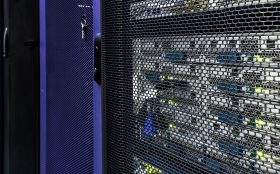Juniper Intros New Switches, Software

Juniper Networks today announced the addition of new switches aimed at the data center, campus environments, branch offices, and the cloud, in addition to a new management system. These additions come on the heels of yet another disappointing financial event for the company.
In the data center, a QFX10002-60C switch can be employed as a spine or an edge device for data center interconnect (DCI). It features 60x100 Gigabit Ethernet (GbE) interfaces. Other additions to Juniper’s switching portfolio include a QFX5210-64C offering that is a 64x100GbE port switch that can function as a leaf spine switch when required, and QFX5200-48Y switch that provides 48 native 25GbE interfaces. There’s also a QFX MACsec line card to provide 30-port 100GbE connectivity for encrypted traffic.
For campus environments Juniper is adding the EX2300, a multi-gigabit switch that has up to 12 ports for 1GbE or 2.5GbE connectivity, and the EX4300 switch that supports up to 24 ports for 1GbE, 2.5GbE, 5GbE and 10GbE access. These switches support both 802.1BR and Ethernet VPN (EVPN) and can be centrally managed using a SkyEnterprise cloud management service that Juniper unfurled today as well.
For the branch office Juniper is adding a NFX150 appliance capable of supporting both 4G and LTE connections, while at the same time making it simpler to configure a virtual firewall running Contrail software-defined wide-area network (SD-WAN).
Finally, Juniper has added support for virtual private clouds running on the Amazon Web Services (AWS) public cloud to its virtual firewall software.
These offering are the latest example of a more comprehensive approach to networking that Juniper is employing in the age of multi-cloud computing, says Mike Bushong, vice president of enterprise cloud marketing. Individual groups within organizations will continue to be responsible for different classes of network services. But over time the total cost of networking in a world consisting of multiple clouds will push organizations with each hardware refresh towards networking equipment that is simpler to manage because every platform runs the same operating system, says Bushong.
The evolution is not going to occur overnight. But Bushong says it’s clear IT organizations will want to standardize on a higher level of abstraction to mask the underlying complexity of networking equipment supporting a wide variety of interfaces and protocols using a common set of orchestration tools. In the future that means networking decisions will be influenced more by software that hardware, says Bushong.
“Previously network decisions have been based on the network architecture,” says Bushong.
Shifts in how networking hardware and software are procured have been a long time coming now. The rise of software-defined networks (SDNs) is clearly having an impact. But inertia within enterprise networking environment has proven to be considerable, and it’s not clear even now to what degree organizations are ready to think more in terms of standardizing on networking software versus continuing to buy network hardware.
Learn how networking is changing in software-defined era. Futuriom’s latest report, SDN 2.0: Monitoring, Analytics and Automation, explains how SDN and network functions virtualization (NFV) platforms are expanding their use of Applications Programming Interfaces (APIs), network telemetry. and analytics to drive automation deep into the network. Use promo code “FOFU” to get a 10% discount.



